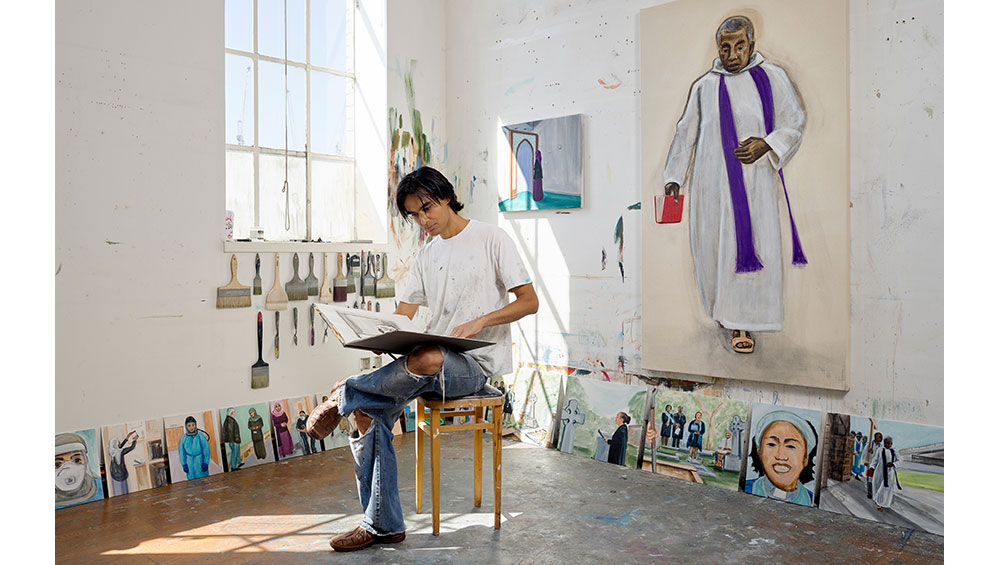
Matthew Krishanu. Photo: Peter Mallet.
by DAVID TRIGG
Memory and imagination are central to the work of the London-based painter Matthew Krishanu (b1980, Bradford), whose figurative paintings explore childhood, religion and the legacies of colonialism and empire. For 11 years, Bangladesh was home to Krishanu, who returned to England on the cusp of teenagehood. This formative period has proved a rich source of inspiration, spawning several bodies of work since he finished his MA at Central Saint Martins in 2009. His Another Country series, for instance, centres on episodes from his childhood adventures; two boys, based on Krishanu and his brother, are shown roaming the expansive Bengal landscape, playing with bows and arrows, climbing trees, rowing boats and exploring ruins.
In Krishanu’s paintings, thin washes of paint commingle with bold, assertive marks. His simple and abbreviated style draws inspiration from Byzantine painting and Luc Tuymans to Mamma Andersson via El Greco. In addition to memory, many scenes are informed by photographs of him and his brother, his parents and their friends. Yet Krishanu is not interested in painting likenesses; his flat, schematised faces exhibit a limited spatial depth in reference to the Ajanta cave paintings, another of his many diverse influences. This lack of specificity allows his images to exist “outside of time”, enabling viewers to bring their own experiences to the work.
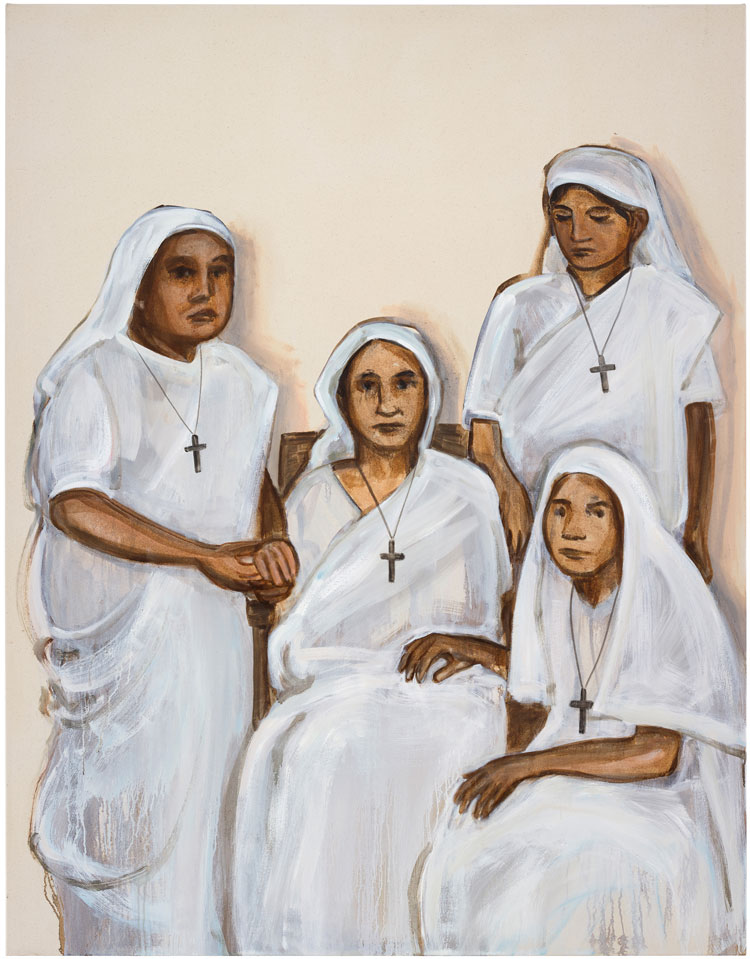
Matthew Krishanu. Four Nuns, 2020. Oil on canvas, 180 x 140 cm. Photo: Peter Mallet.
Yet Krishanu’s uncomplicated aesthetic belies a web of complexities: historical and cultural undercurrents that serve to problematise his beguiling images. The history of modern Bangladesh and India is inextricably intertwined with British intervention and Krishanu has noted that, just as his own existence cannot be disentangled from colonial history, the ostensibly innocent childhood world of his paintings “is easily punctured by adult constructions and beliefs”.
Adult roles and rituals are explored in Krishanu’s Expatriates and Mission series. The former documents the international expat community in Dhaka, while the latter features Christian missionaries and priests engaged in various scenes of ceremony and religiosity. The main protagonist in these works is Krishanu’s white British father, whose post as a priest in the Church of Bangladesh led him, his Bengali Indian wife and two children to Dhaka in 1981. The family lived on the ground floor, beneath the church, and while the building was Krishanu’s home, he never truly felt a part of church life and observed its activities from a distance.
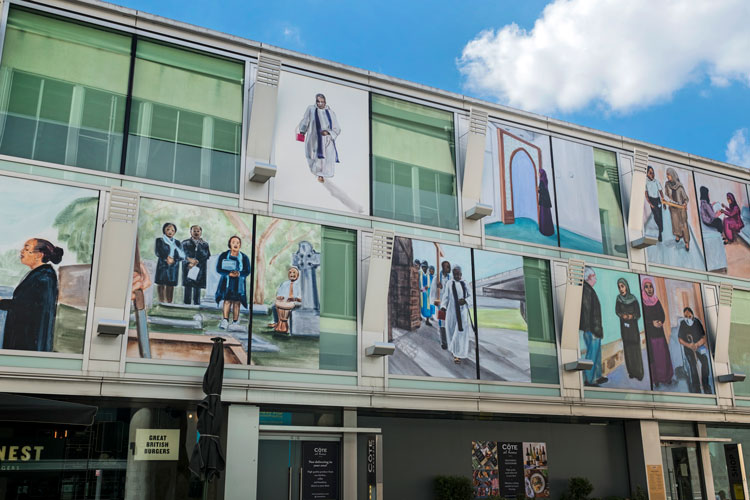
Matthew Krishanu's works at Southbank Centre's Everyday Heroes, 2020. Copyright the artist. Photo: Linda Nylind.
Krishanu’s interest in people of faith inspired his contribution to the Southbank Centre’s Everyday Heroes exhibition in autumn 2020, which responded to the Covid-19 pandemic with a vivid outdoor celebration of key and frontline workers. Departing from childhood memories, his paintings of contemporary religious workers marked a significant step change within his practice. But whether he is circling religious belief, gender politics, issues of class or post-colonialism, his works resist polemics, instead inviting conversation and rumination.
Studio International spoke to Krishanu as he prepared for a busy season of exhibitions, including his participation in the Hayward Gallery’s ambitious survey of contemporary painting Mixing It Up: Painting Today, a commission for the Coventry Biennial and a solo exhibition at the Tanya Leighton Gallery in Berlin.
David Trigg: Although many of your paintings are derived from photographs found in family albums, invention also plays a large role. How do you negotiate the balance between photographic record and invention in your painting?
Matthew Krishanu: I think of it as a triangle. First, there are works that I paint or map out in a sketchbook without any photographic reference. These are entirely from my imagination or memory. Second, there are photographs – memory always filters out the hard edge of detail, so photographs introduce the particular to the generic. I want my paintings to exist somewhere between the precision of a photograph and something looser and more provisional. The third side of the triangle is art history and the world of painting, which hugely influences me. I’m interested in knitting together a visual language from the history of painting – I’m very aware that any painting I put into the world will be read in relation to that history.
DT: Are we talking figurative painting specifically?
MK: Yes, I was very excited by the explosion of pictorial painting in the 1990s and 2000s and coming across artists such as Peter Doig, Chris Ofili, Mamma Andersson, Lynette Yiadom-Boakye, Chantal Joffe and so many others. I feel that my work relates to the languages of these painters, but I also look at Walter Sickert, Félix Vallotton, Francisco Goya, Édouard Manet, Horace Pippin and El Greco among others.
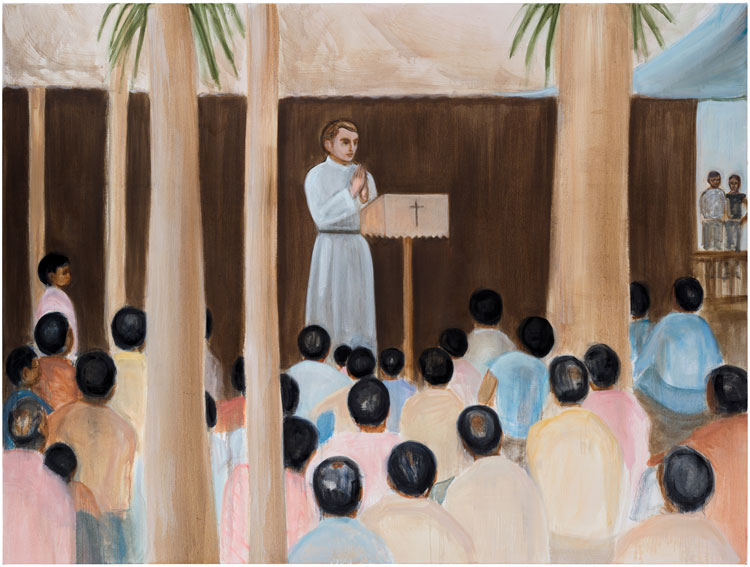
Matthew Krishanu. Mission, 2020. Oil on canvas, 180 x 240 cm. Photo: Peter Mallet.
DT: Do the photographs you use all come from your family’s albums?
MK: No, they also come from people I knew in my childhood who have photographs of that era. The photographs don’t have to be my personal memories, but I do need to feel anchored to them. I don’t do the Wilhelm Sasnal thing of searching in the newspapers or online for other people’s images, it’s more first-hand research of a time that I knew well and places that I know.
DT: When you start a new painting, are you typically working from an image that has been roughed out in the sketchbook or do you use the photographs as well?
MK: Quite often I will have a photograph that I’ve printed out on A4 or A5. I might also have sketched out some ideas before, sometimes even painted the image on a smaller scale, but each time I approach a work, even if it’s the same image, it’s as if I’m starting again from scratch because I refer to these sources quite loosely and will allow the composition to develop organically.
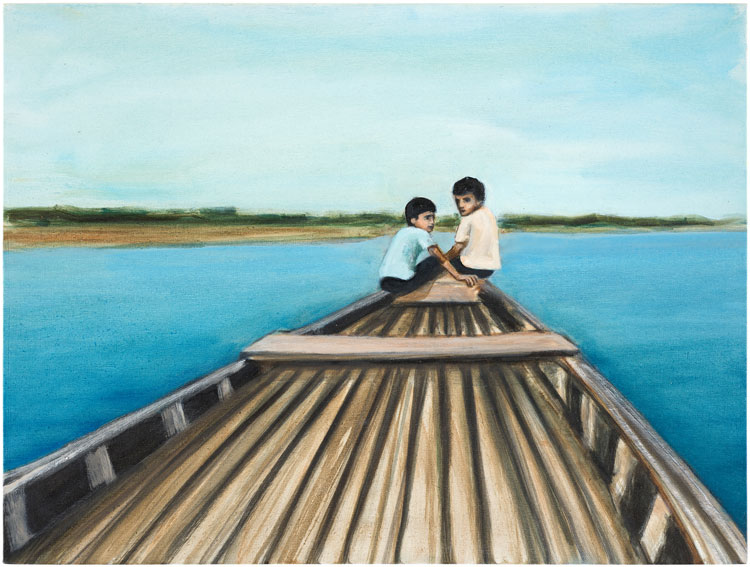
Matthew Krishanu. Two Boys on a Boat, 2019. Oil on board, 46 x 61 cm. Collection of Huddersfield Art Gallery. Photo: Peter Mallet.
DT: Most of the paintings in your Another Country series feature the same two boys, who are based on you and your elder brother. To what extent do you consider these works to be autobiographical?
MK: I don’t require the viewer to know that they are based on me and my brother and, while they come from an autobiographical source, autobiography isn’t the intention. The boys in my paintings are like avatars. When I saw children looking at my paintings in the Midlands Arts Centre, I realised that the painted boys could become their avatars – they allow the viewer to project themselves into the painting and it’s that projection which I’m most interested in. When the faces look too much like me and my brother, I feel that the work becomes more of a pictorial representation of two particular people at a particular time. What I’m really interested in is creating a vessel that enables the viewer to inhabit these spaces and inhabit these people, and for these people to then live in the world of painting.
DT: Has childhood always played a role in your work?
MK: Childhood is something I’ve circled for a long time, going back to my BA in Exeter. (Krishanu studied for a BA in English and fine art at Exeter.) The impact of childhood experience is so resonant because I moved to England at the age of 12; all the atmospheres of early childhood ended when I left Bangladesh and started living in a completely different world. The paintings I’m making now are about revisiting a whole set of emotions and atmospheres, elements that I think of as being very much a part of me.
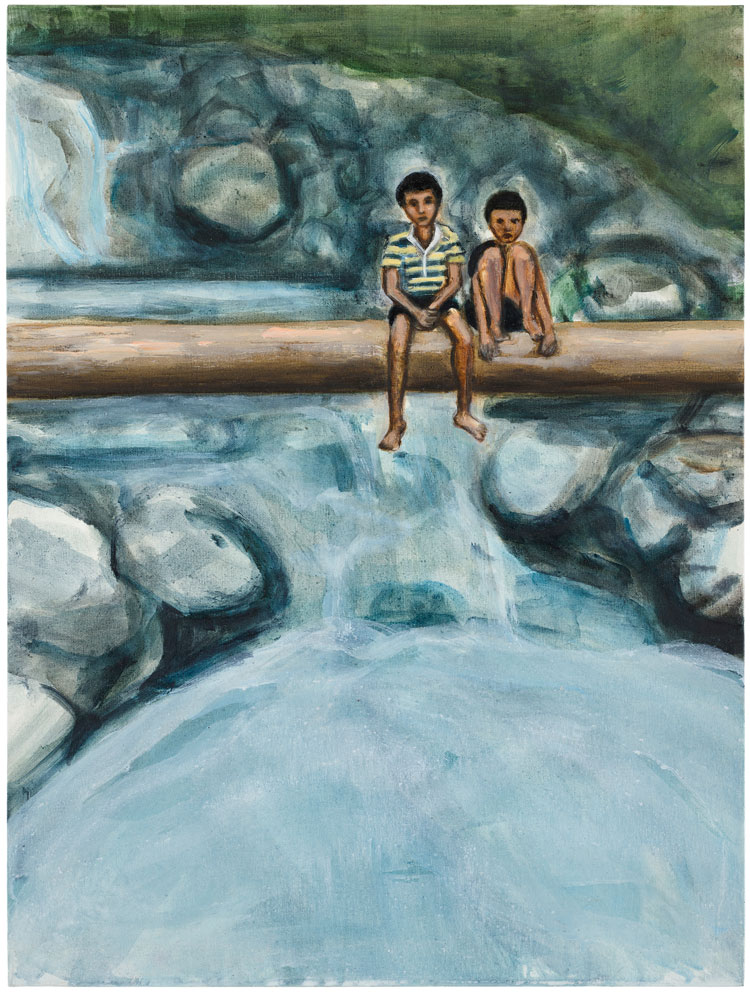
Matthew Krishanu. Two Boys on a Log, 2019. Oil on board, 61 x 46 cm. Collection of Huddersfield Art Gallery. Photo: Peter Mallet.
DT: Through the work of your parents, and in particular your father, your early life was bound up with the Christian church in Dhaka. Your Mission series explicitly tackles the theme of faith and religious ceremony, depicting missionaries and priests in Bangladesh and India. These are unusual subjects in contemporary painting. What led you to start the series?
MK: I’m not a practising Christian, it’s something I’ve rejected, largely due to the personification of God as an old white European man with a beard – which is extraordinary given the Asian and African roots of Christianity – but I knew I wanted to paint about religion, as opposed to making religious paintings. I started the Mission series in 2010 and, though I was concerned that they would too easily be misinterpreted, it was an itch that I wanted to scratch.
DT: Many of the paintings portray your father, who worked as a priest for the Church of Bangladesh.
MK: I’m interested in portraying whiteness as otherness, so when I paint my father as a white priest in front of an Asian congregation, he becomes other to the world that I’ve constructed in the paintings. Although it’s something I find troubling and problematic, I don’t really have a definite position on how I want people to read the work. They’re not like Bacon’s Pope paintings, I don’t want to paint about religion in a polemical way but in a way that develops the conversation around it.
DT: While some viewers might assume that your juxtaposition of a white minister with brown-skinned congregants is making a polemical point, others might see these scenes as more benevolent. These mixed readings speak to an ambiguity that runs through all your work.
MK: I find it really offputting if the subject is completely closed, so it’s about constructing different elements within a painting that play off each other. I sometimes get people who really can’t look at the Mission paintings and then I find out that they were raised by Catholic nuns in Ireland or something, so I realise that they will hold people at bay more than, say, my Another Country or Other Places paintings. But in all of them I want to give the viewer – and that includes myself – a space to respond.
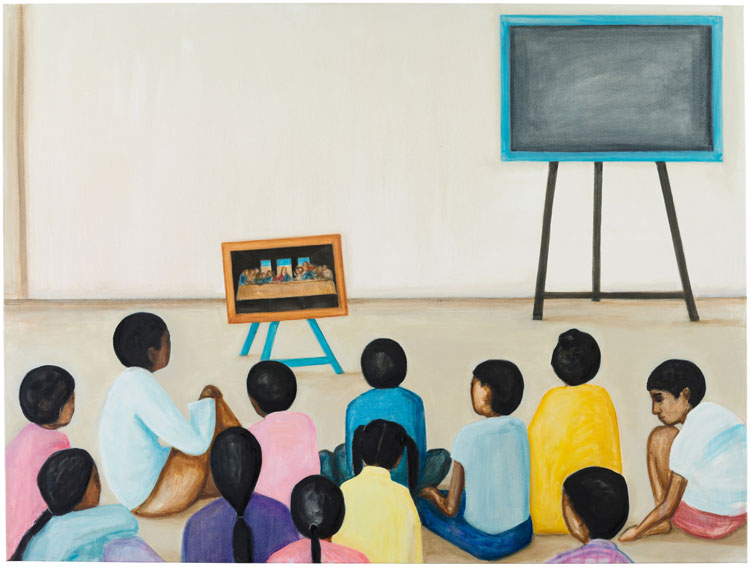
Matthew Krishanu. Mission School, 2017. Oil on canvas, 150 x 200 cm. Photo: Peter Mallet.
DT: Your large painting Mission School (2017) shows a group of children sitting in front of a reproduction of Leonardo da Vinci’s Last Supper mural. What was the starting point for this work?
MK: I had a print of Da Vinci’s Last Supper above my childhood bed in Bangladesh, but I never really thought of it as art history, it was always a symbol of religion and of western culture. Mission School is about the way that western art has depicted Christ as European. People don’t talk about the real-world impact that these works have had as religious tools and – let’s get polemical – as tools of white superiority and supremacy. Essentially, that’s what is happening a lot of the time in African, Indian and South American mission schools, where brown children are being handed books showing Christ and the saints as white and good little children that are white and blond. That was something I was aware of as a child and, as a teenager, that was one of the reasons why I told my parents I wouldn’t be confirmed, because I didn’t want to be a part of all that.
DT: One child, whose face we see in profile, appears to be disengaged.
MK: He wasn’t in the original photograph, he’s an entry point for the viewer. He was originally facing out, but I found that it led the eye too much to that figure, so I turned him to face in. In a way, he is a stand-in for me and my brother, which comes back to the idea of avatars. The painting is also about interiority. Brown children have been objectified in paintings – Gauguin is a good example and, when you look at Orientalist paintings, it’s clear that there isn’t any interiority, these are people who have been pinned down on the canvas almost like specimens. When children, particularly children of colour, look at my paintings, they can project themselves on to it; that’s why I wanted to create a scene where, as a viewer, you can almost join the children in the schoolroom.
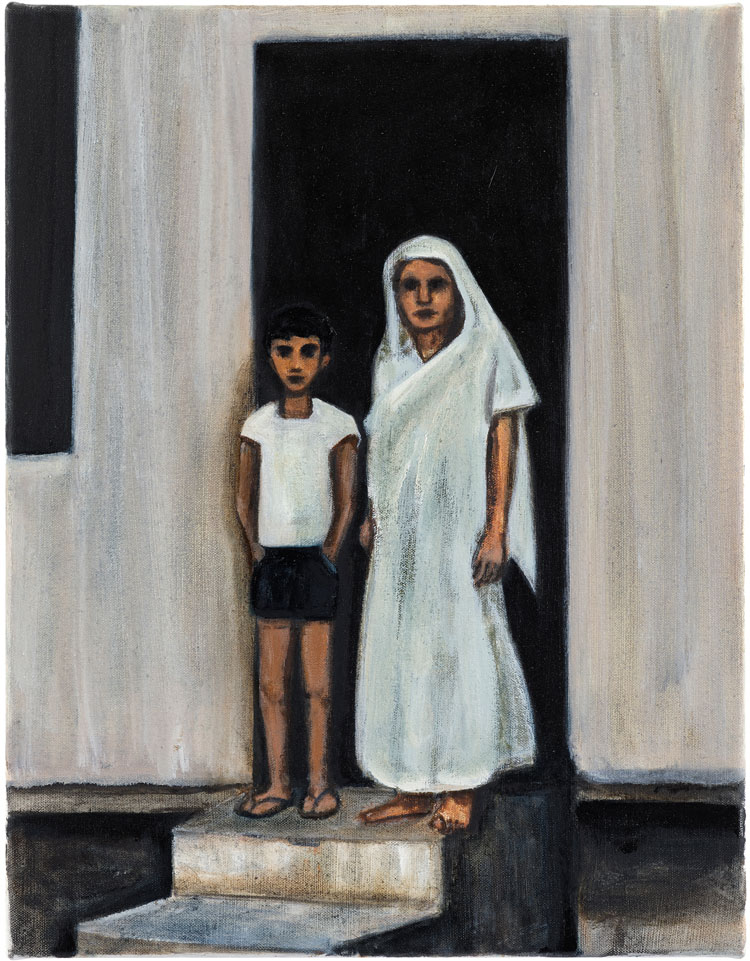
Matthew Krishanu. Boy and Nun, 2020. Oil on canvas, 45 x 35 cm. Photo: Peter Mallet.
DT: These scenes of Christian ritual and ceremony offer an interesting counter to your paintings in which children are shown roaming the landscape. What is the relationship between these two bodies of work?
MK: There are crossovers, as with Boy and Nun (2020) but, essentially, I think of the children as being in their own world, at one with nature, whereas the adults inhabit a largely interior and stuffy space: the church. I don’t deliberately paint the religious paintings to look pompous, but when you show the two series against each other there’s a very different atmosphere. It’s worth noting that the religious paintings are also about role play, about dressing up in costumes and different people having different roles.
,-2020.jpg)
Matthew Krishanu. Two Boys (Church Tower), 2020. Oil on canvas, 45 x 35 cm. Photo: Peter Mallet.
DT: Both themes come together, albeit subtly, in Two Boys (Church Tower, 2020). There is a church tower in the background and the boys in the foreground almost look as if they are standing in a pulpit.
MK: The first version of this painting had the church tower as just another building in the background, but I changed the orientation to portrait format with the church tower in the ascendant. The boys are actually in an abandoned water tank that was in an old Christian missionary compound with ruined crumbling buildings that we used to play in. I hadn’t made the formal connection to a pulpit before, but I really like that reading. I’m increasingly interested in the porous divisions between my different series and teasing apart the relationships, not just between Brown and white but also child and adult.
DT: Your painting style is very direct, displaying an apparent simplicity that I imagine is not always easy to achieve. How did it develop?
MK: I think of my painting like writing: I try to communicate without using unnecessary words. Distilling is something that I care about; I don’t want showy marks. The relationship between figure and ground is really important and I treat them differently – the ground will be flat but have a textural element to it, whereas figures will often be painted more opaquely. Faces are also really important, and I’ll paint them again and again if necessary, wiping the paint back and sometimes sanding the surface until I achieve an expression that can become a vessel for the viewer to fill. It’s not about creating a particular likeness, it’s more about conveying a certain emotion or expression. But in terms of how I like to handle the paint and how I compose a painting, all those things have developed organically.
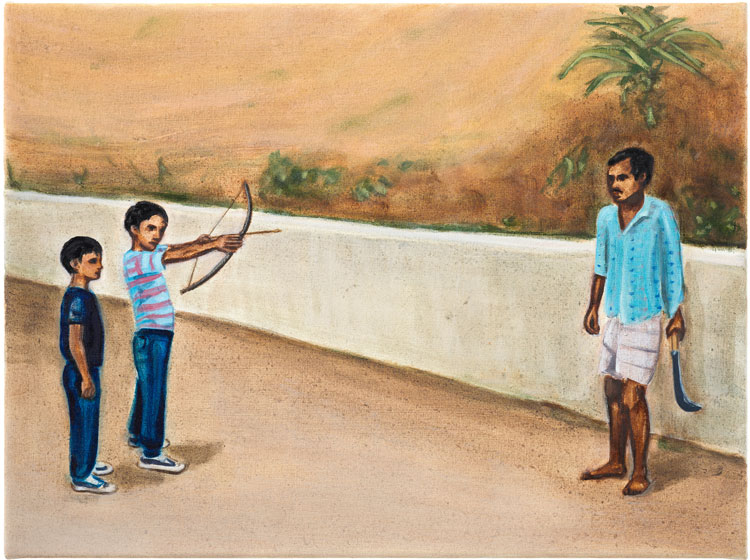
Matthew Krishanu. Weapons, 2021. Oil on canvas, 45 x 60 cm. Courtesy of the artist and Jhaveri Contemporary. Photo: Peter Mallet.
DT: Sometimes you revisit images. Take, for instance Weapons (2021), which is a new version of a 2018 painting depicting two boys with a bow and arrow standing alongside an adult holding a machete. You have shifted the palette, introducing warmer, earthier hues.
MK: I have always thought of that scene as being almost like a stage with figures that can be moved around. I’ve always liked the dynamic between the figures, it’s a bit like a mousetrap – you get things as taut as possible and then you leave it. It felt like a pregnant image, and I didn’t feel that I had fully exhausted its potential in the first version. That’s why I wanted to go back and explore it again.
DT: It looks at first as if the boys are about to shoot the man. There is a backstory to the image, isn’t there?
MK: I’m not so interested in backstories because often I don’t think they’re very interesting, they actually make the works less interesting a lot of the time. Why I painted this image has nothing to do with the backstory, it has everything to do with what you first see: are they going to shoot the man? Is he dangerous? Why are they wearing trainers and western clothes? What’s the class relationship? What’s the adult/child relationship?
DT: I like the ambiguity. That machete could be a serious weapon, or it could just be a tool of craft. Again, the bow and arrow could just be a toy or it could inflict real injury. It talks of the potential for childhood games to spill over into real violence in the adult world.
MK: I want there to be an element of danger in the painting. That’s true of many of the paintings in the Another Country series.
DT: You have a very distinctive language of colour. Are your palettes dictated by your source material or are they another invention drawn from personal experience?
MK: Tal R has said that his secret to painting is dirty brushes but mine’s the opposite: I need loads of clean brushes and I will paint having already visually imagined the colour. When I reach for my brush, essentially, I have two thoughts: which brush to choose (all my brushes are laid out by size and shape, and I use 30 or more brushes a session) and what colour to find. The colours in the photographs lead into the paintings, but I don’t colour match. Sometimes, the contrast might need to be increased, or I’ll amp up the tonal relationships. I work out what the painting needs as I go.
DT: How has the pandemic affected you and your work?
MK: It gave me a lot of studio time, but, at the beginning of lockdown, I couldn’t really paint because there was too much happening. No one knew where things were going at that time, so I just listened to the radio while stretching canvases, clearing up and doomscrolling. After about three weeks or so I started painting again. I worked on paintings of nuns for my Holy Family series. I was listening to the news, hearing about socially distanced funerals and thinking about religious workers like that all over the world.
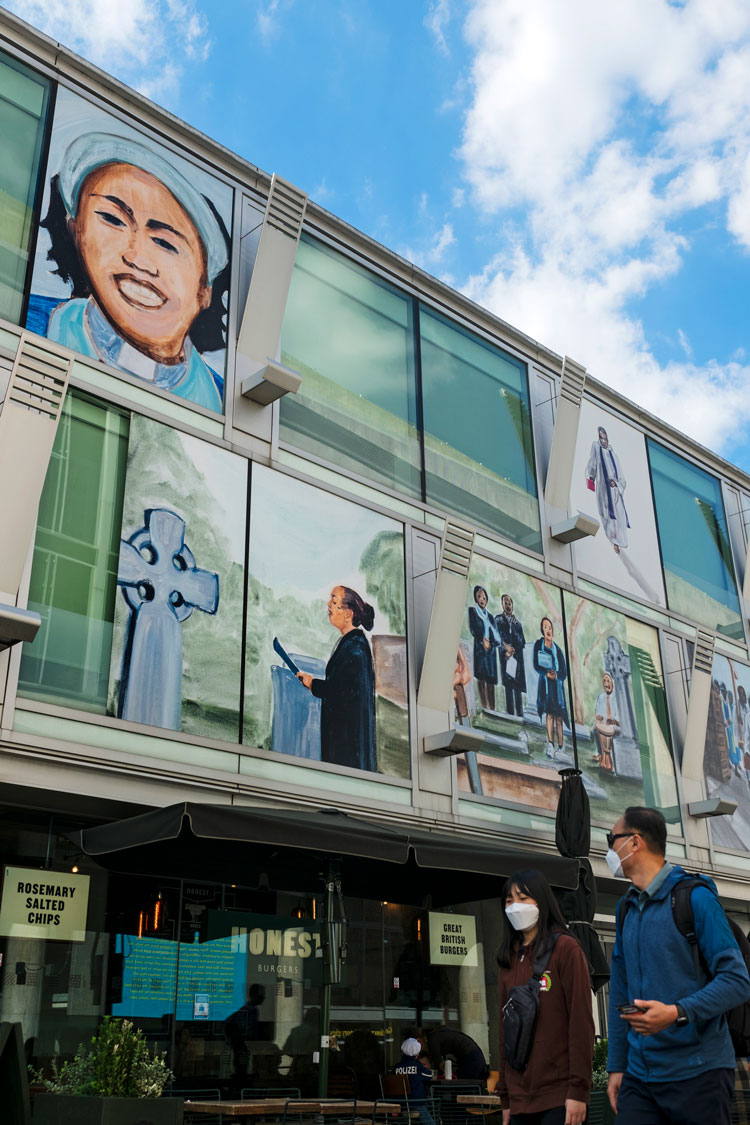
Matthew Krishanu's works at Southbank Centre's Everyday Heroes, 2020. Copyright the artist. Photo: Linda Nylind.
DT: In autumn 2020, you exhibited in the Southbank Centre’s Everyday Heroes show, an open-air exhibition celebrating key and frontline workers during the pandemic. Your contribution focused on four female religious workers, figures who are often overlooked in an increasingly secularised world. What led you to this group of individuals?
MK: Cedar Lewisohn from the Hayward phoned me up out of the blue and told me about the project. I told him that I don’t really do portraits and I don’t do commissions. But after a while I thought maybe I could show my new nun paintings, but that felt wrong because the show was meant to be about what was happening now. Then I thought about the idea of religious workers as key workers, which had a lot of resonance for me. My parents have all these great contacts in Birmingham: Rehanah Sadiq is a Muslim chaplain for two Birmingham NHS hospital trusts, she is a family friend, as are Rabbi Dr Margaret Jacobi, Rev Canon Eve Pitts (Britain’s first Black female Church of England vicar) and Rev Deseta Davis (a prison chaplain). That they were all women was a coincidence – I also invited a male Hindu chaplain, but he was unavailable.
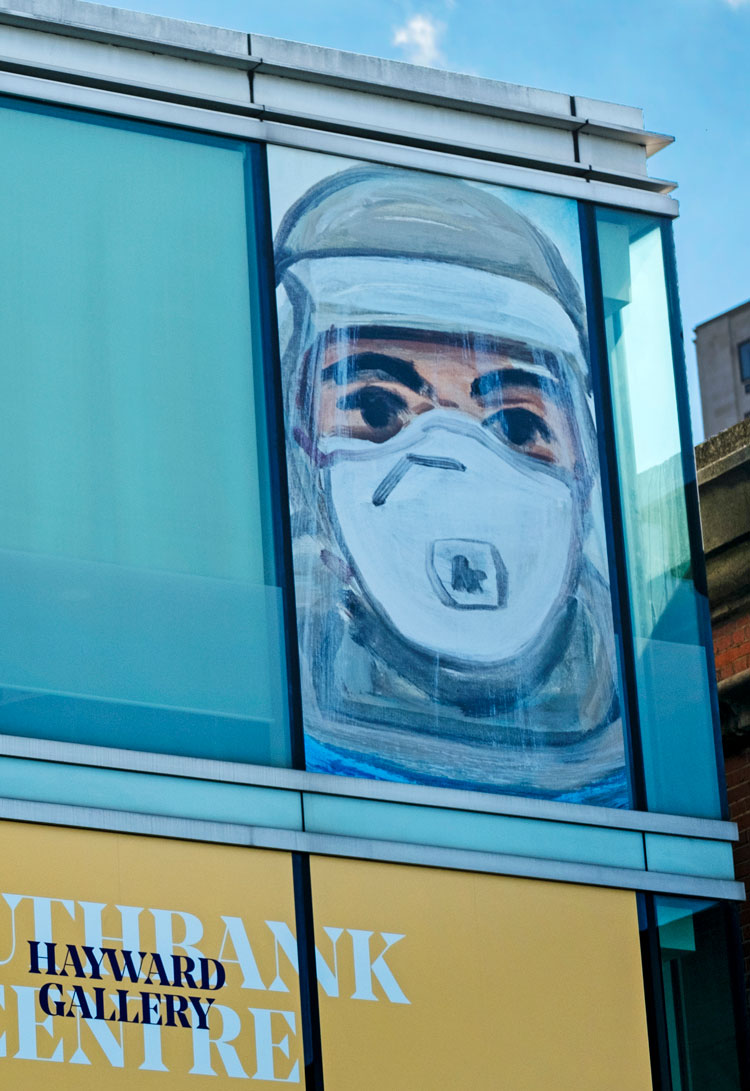
Matthew Krishanu's works at Southbank Centre's Everyday Heroes, 2020. Copyright the artist. Photo: Linda Nylind.
DT: You ended up producing quite a lot of work for the show.
MK: I had been working towards my exhibition at the Niru Ratnam Gallery, Picture Plane, and the Hayward show took me entirely by surprise. I only had six weeks, so I decided to make just one work on paper, because that was all that was required. But I couldn’t stop. I put down my brushes for Picture Plane and totally immersed myself in the Everyday Heroes series. Rehanah sent me all these amazing images that I wanted to paint and so it grew and grew. I loved it because it gave me a certain freedom. A lot of the paintings were done with acrylics so I could be quite provisional, working quite small and fast yet knowing that they would have a big impact when enlarged as prints and shown in the public realm.
DT: What was the response like?
MK: What was nice was seeing the Everyday Heroes hashtag on Instagram, seeing people just coming across the work and sometimes videoing the whole thing. I noticed a Jewish woman photographing my painting of Margaret Jacobi for instance, and Rehanah’s daughter called her up to tell her that her friends had noticed the pictures of her around the Southbank Centre. I never intended them to be exact likenesses, but my paintings clearly communicated something of her spirit.
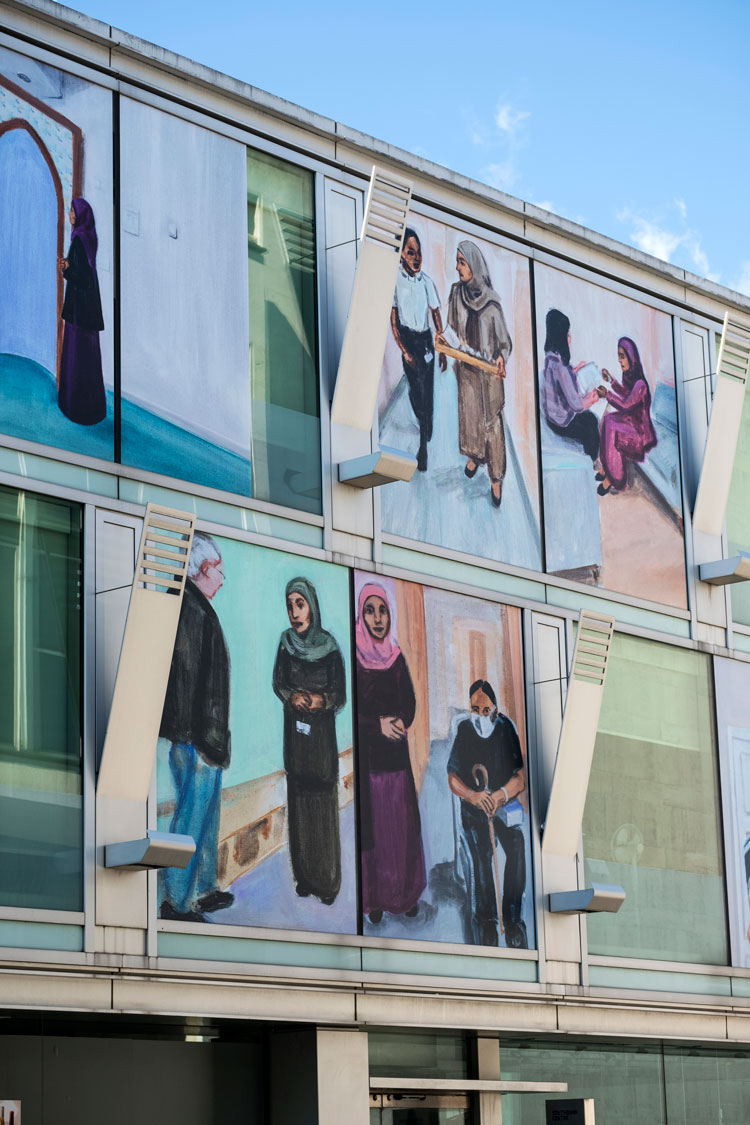
Matthew Krishanu's works at Southbank Centre's Everyday Heroes, 2020. Copyright the artist. Photo: Linda Nylind.
DT: You are back at the Hayward Gallery this autumn, showing work in the group exhibition Mixing It Up: Painting Today.
MK: My inclusion in Mixing It Up arose out of Everyday Heroes – that’s how Ralph Rugoff, the exhibition’s curator, came across my work. The show will be really exciting, especially as many of the included artists, such as Lisa Brice, Peter Doig and Hurvin Anderson, are painters whom I really look up to and admire.
DT: What is it about painting that you find so compelling?
MK: Discovering painting was like having a door open on to a whole new world of imagination. I actually started as a sculptor, and it was only in the last three months of my BA that I moved to painting. I’d come to a dead end with sculpture, and it was my housemate, who was on the same course, who said: “Look, it’s your works on paper, it’s your drawings with ink that really communicate.” With painting I have the absolute freedom to explore everything that I care about. I’ve not come across any other medium that allows me to traverse as much territory as freely as I do with painting.
• Matthew Krishanu’s work is included in Mixing It Up: Painting Today, at the Hayward Gallery, London, 9 September to 12 December 2021, and in Coventry Biennial, various venues Coventry, 8 October 2021 – 23 January 2022. His solo exhibition at Tanya Leighton, Berlin, runs from 6 November to 17 December 2021.